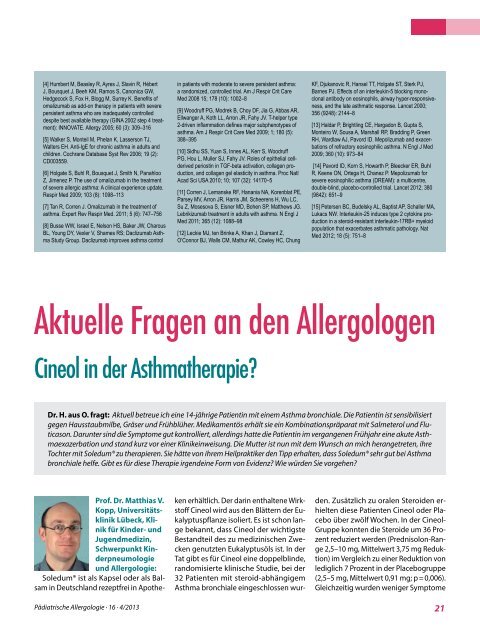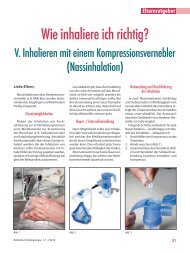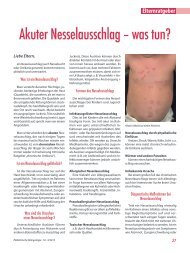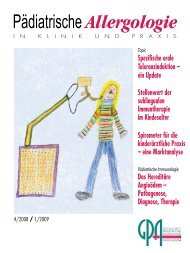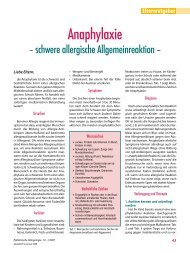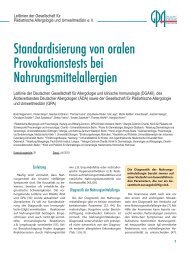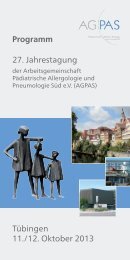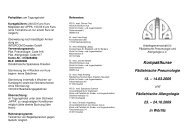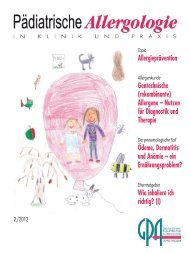Asthmatherapie mit Biologika – Stand der Entwicklung
Asthmatherapie mit Biologika – Stand der Entwicklung
Asthmatherapie mit Biologika – Stand der Entwicklung
Erfolgreiche ePaper selbst erstellen
Machen Sie aus Ihren PDF Publikationen ein blätterbares Flipbook mit unserer einzigartigen Google optimierten e-Paper Software.
[4] Humbert M, Beasley R, Ayres J, Slavin R, Hébert<br />
J, Bousquet J, Beeh KM, Ramos S, Canonica GW,<br />
Hedgecock S, Fox H, Blogg M, Surrey K. Benefits of<br />
omalizumab as add-on therapy in patients with severe<br />
persistent asthma who are inadequately controlled<br />
despite best available therapy (GINA 2002 step 4 treatment):<br />
INNOVATE. Allergy 2005; 60 (3): 309<strong>–</strong>316<br />
[5] Walker S, Monteil M, Phelan K, Lasserson TJ,<br />
Walters EH. Anti-IgE for chronic asthma in adults and<br />
children. Cochrane Database Syst Rev 2006; 19 (2):<br />
CD003559.<br />
[6] Holgate S, Buhl R, Bousquet J, S<strong>mit</strong>h N, Panahloo<br />
Z, Jimenez P. The use of omalizumab in the treatment<br />
of severe allergic asthma: A clinical experience update.<br />
Respir Med 2009; 103 (8): 1098<strong>–</strong>113<br />
[7] Tan R, Corren J. Omalizumab in the treatment of<br />
asthma. Expert Rev Respir Med. 2011; 5 (6): 747<strong>–</strong>756<br />
[8] Busse WW, Israel E, Nelson HS, Baker JW, Charous<br />
BL, Young DY, Vexler V, Shames RS; Daclizumab Asthma<br />
Study Group. Daclizumab improves asthma control<br />
in patients with mo<strong>der</strong>ate to severe persistent asthma:<br />
a randomized, controlled trial. Am J Respir Crit Care<br />
Med 2008 15; 178 (10): 1002<strong>–</strong>8<br />
[9] Woodruff PG, Modrek B, Choy DF, Jia G, Abbas AR,<br />
Ellwanger A, Koth LL, Arron JR, Fahy JV. T-helper type<br />
2-driven inflammation defines major subphenotypes of<br />
asthma. Am J Respir Crit Care Med 2009; 1; 180 (5):<br />
388<strong>–</strong>395<br />
[10] Sidhu SS, Yuan S, Innes AL, Kerr S, Woodruff<br />
PG, Hou L, Muller SJ, Fahy JV. Roles of epithelial cell<strong>der</strong>ived<br />
periostin in TGF-beta activation, collagen production,<br />
and collagen gel elasticity in asthma. Proc Natl<br />
Acad Sci USA 2010; 10; 107 (32): 14170<strong>–</strong>5<br />
[11] Corren J, Lemanske RF, Hanania NA, Korenblat PE,<br />
Parsey MV, Arron JR, Harris JM, Scheerens H, Wu LC,<br />
Su Z, Mosesova S, Eisner MD, Bohen SP, Matthews JG.<br />
Lebrikizumab treatment in adults with asthma. N Engl J<br />
Med 2011; 365 (12): 1088<strong>–</strong>98<br />
[12] Leckie MJ, ten Brinke A, Khan J, Diamant Z,<br />
O‘Connor BJ, Walls CM, Mathur AK, Cowley HC, Chung<br />
KF, Djukanovic R, Hansel TT, Holgate ST, Sterk PJ,<br />
Barnes PJ. Effects of an interleukin-5 blocking monoclonal<br />
antibody on eosinophils, airway hyper-responsiveness,<br />
and the late asthmatic response. Lancet 2000;<br />
356 (9248): 2144<strong>–</strong>8<br />
[13] Haldar P, Brightling CE, Hargadon B, Gupta S,<br />
Monteiro W, Sousa A, Marshall RP, Bradding P, Green<br />
RH, Wardlaw AJ, Pavord ID. Mepolizumab and exacerbations<br />
of refractory eosinophilic asthma. N Engl J Med<br />
2009; 360 (10): 973<strong>–</strong>84<br />
[14] Pavord ID, Korn S, Howarth P, Bleecker ER, Buhl<br />
R, Keene ON, Ortega H, Chanez P. Mepolizumab for<br />
severe eosinophilic asthma (DREAM): a multicentre,<br />
double-blind, placebo-controlled trial. Lancet 2012; 380<br />
(9842): 651<strong>–</strong>9<br />
[15] Petersen BC, Budelsky AL, Baptist AP, Schaller MA,<br />
Lukacs NW. Interleukin-25 induces type 2 cytokine production<br />
in a steroid-resistant interleukin-17RB+ myeloid<br />
population that exacerbates asthmatic pathology. Nat<br />
Med 2012; 18 (5): 751<strong>–</strong>8<br />
Aktuelle Fragen an den Allergologen<br />
Cineol in <strong>der</strong> <strong>Asthmatherapie</strong>?<br />
Dr. H. aus O. fragt: Aktuell betreue ich eine 14-jährige Patientin <strong>mit</strong> einem Asthma bronchiale. Die Patientin ist sensibilisiert<br />
gegen Hausstaubmilbe, Gräser und Frühblüher. Medikamentös erhält sie ein Kombinationspräparat <strong>mit</strong> Salmeterol und Fluticason.<br />
Darunter sind die Symptome gut kontrolliert, allerdings hatte die Patientin im vergangenen Frühjahr eine akute Asthmaexazerbation<br />
und stand kurz vor einer Klinikeinweisung. Die Mutter ist nun <strong>mit</strong> dem Wunsch an mich herangetreten, ihre<br />
Tochter <strong>mit</strong> Soledum® zu therapieren. Sie hätte von ihrem Heilpraktiker den Tipp erhalten, dass Soledum® sehr gut bei Asthma<br />
bronchiale helfe. Gibt es für diese Therapie irgendeine Form von Evidenz? Wie würden Sie vorgehen?<br />
Pädiatrische Allergologie ∙ 16 ∙ 4/2013<br />
Prof. Dr. Matthias V.<br />
Kopp, Universitätsklinik<br />
Lübeck, Klinik<br />
für Kin<strong>der</strong>- und<br />
Jugendmedizin,<br />
Schwerpunkt Kin<strong>der</strong>pneumologie<br />
und Allergologie:<br />
Soledum® ist als Kapsel o<strong>der</strong> als Balsam<br />
in Deutschland rezeptfrei in Apotheken<br />
erhältlich. Der darin enthaltene Wirkstoff<br />
Cineol wird aus den Blättern <strong>der</strong> Eukalyptuspflanze<br />
isoliert. Es ist schon lange<br />
bekannt, dass Cineol <strong>der</strong> wichtigste<br />
Bestandteil des zu medizinischen Zwecken<br />
genutzten Eukalyptusöls ist. In <strong>der</strong><br />
Tat gibt es für Cineol eine doppelblinde,<br />
randomisierte klinische Studie, bei <strong>der</strong><br />
32 Patienten <strong>mit</strong> steroid-abhängigem<br />
Asthma bronchiale eingeschlossen wurden.<br />
Zusätzlich zu oralen Steroiden erhielten<br />
diese Patienten Cineol o<strong>der</strong> Placebo<br />
über zwölf Wochen. In <strong>der</strong> Cineol-<br />
Gruppe konnten die Steroide um 36 Prozent<br />
reduziert werden (Prednisolon-Range<br />
2,5<strong>–</strong>10 mg, Mittelwert 3,75 mg Reduktion)<br />
im Vergleich zu einer Reduk tion von<br />
lediglich 7 Prozent in <strong>der</strong> Placebogruppe<br />
(2,5<strong>–</strong>5 mg, Mittelwert 0,91 mg; p = 0,006).<br />
Gleichzeitig wurden weniger Symptome<br />
21


